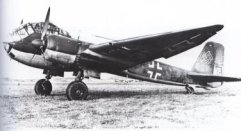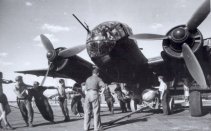
Junkers Ju 188
Germany's air ministry (RLM) issued the 'Bomber B' requirement for a twin-engined replacement for the He 111 and Ju 88 in 1939. Junkers' candidate was the Ju 288, a radical development of its earlier bomber design that was making its mark in the early years of the war in Europe. However, by late 1942, the ill-fated Ju 288 design was hopelessly delayed, leaving the Luftwaffe with a need to urgently fill the bomber requirement. This paved the way for the more conventional Ju 188.
This first true Ju 188 (Ju 188 V1) was the Ju 88 prototypeV44, a Ju 88E airframe with a new dorsal turret and 13 mm (0.51 in) machine gun, extended wingtips and a square tail fin. By January 1943, a second aircraft, Ju 188 V2, was under test. Production aircraft would be powered by Jumo 213 in-line or BMW 801 radial engines.
On 18 August 1943, French-based Ju 188s flew their first sortie, pathfinding for a bombing raid over northern England. By the end of 1943, 283 had been accepted by the Luftwaffe. In January 1944, 188s took part in Operation Steinbock, Germany's retaliatory 400 bomber raid on London.
The BMW engined Ju 188Es (some of which were fitted with dive brakes) and Jumo powered Ju 188As (which also sported a dorsal cannon in place of the machine-gun and MW50 engine power boosting) were the initial variants - medium bombers with a 3,000 kg (6,600 lbs) bombload.
However, 570 of the 1076 Ju 188s were 188D and F reconnaissance marks. Some were fitted with FuG 200 radar for the maritime role, these aircraft seeing action in Russia and Scandinavia, often in concert with Ju 188A-3 and E-2 torpedo bombers.
 |
 |
 |
| Ju 188D-2s of 1.(F)/124 at Kirkenes in Arctic Norway. The nearest aircraft appears to have had its FuG 200 Hohentwiel radar removed. |
Over half the Ju 188s completed were for reconnaissance duties. Ju 188s were able to make better use of the power of the BMW 801 and Jumo 213 than was the Ju 88. |
A victim of the success of the Ju 88, the Ju 188 failed to be produced in sufficient numbers to have a significant effect on the Luftwaffe's fortunes. |
|
Junkers Ju 188 (Technical Specification) |
| Role |
Maritime reconnaissance and strike aircraft |
| Manufacturer |
Junkers |
| Maximum Speed |
539 kmh (334 mph) |
| Maximum Range |
3,395 km (2,100 miles) |
| Ceiling |
10,000 meters (32,800 feet) |
Weight
Empty
Maximum Takeoff |
9,900 kg (21,780 lbs)
15,195 kg (33,430 lbs) |
Dimensions
Wingspan
Length
Height
Wing Area |
22.00 meters (72 ft 2 in)
14.95 meters (49 ft)
4.44 meters (14 ft 7 in)
56.00 square meters (603 sq ft) |
| Engines |
Two Junkers Jumo 213A-1 12-cylinder inline engines each providing 1268-kW (1,700-hp) |
| Armament |
One 20 mm (0.79 in) MG 151 cannon in dorsal turret
One 13 mm (0.51 in) MG 131 machine-gun in the rear cockpit
One 7.9 mm (0.31 in) MG 81z twin machine-gun in ventral step |
Photo Gallery
[an error occurred while processing this directive]
Click here to submit your photo
| Have A Passion For Aircraft? |
Subscribe to our 14 series FREE newsletter
delivered weekly on World War 2 Aircraft factfile... |
| NB:- We hate spam as much as you do, so your email address will NEVER be shared with or sold to anyone else. That's a Guarantee. |
|
|





